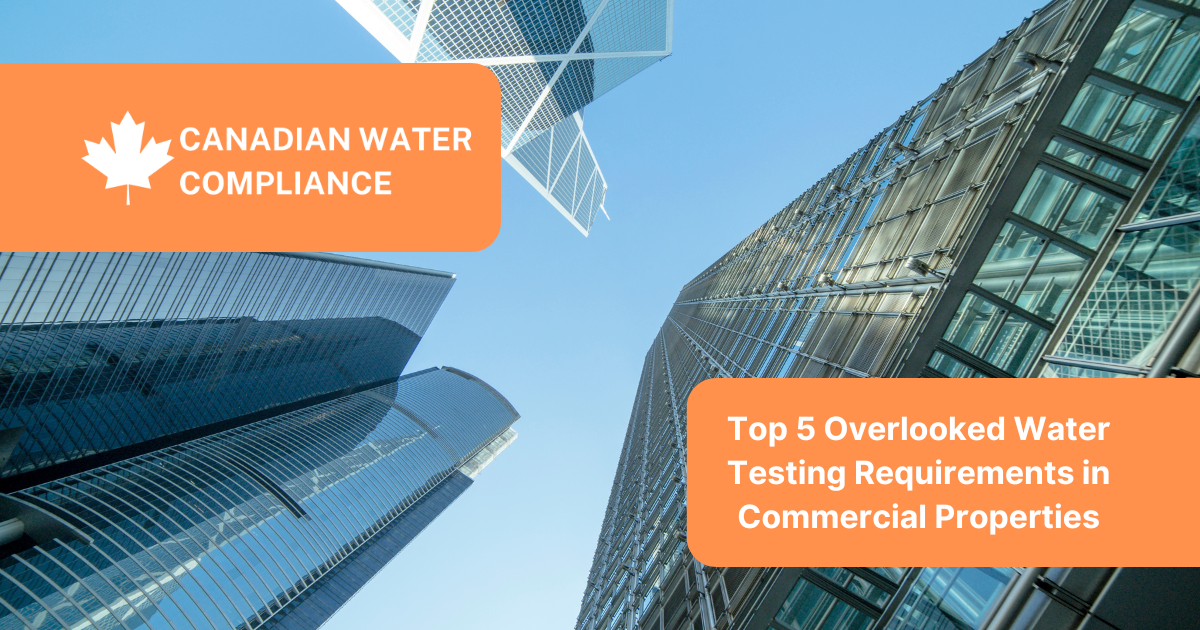
Written By: Canadian Water Compliance | On
Why Some of the Most Important Water Testing Obligations Are Still Missed
In Ontario, commercial property owners are bound by multiple pieces of legislation that govern the safety and quality of water within their buildings. Yet, despite these regulations, some of the most essential water testing requirements continue to fly under the radar. When overlooked, these gaps can lead to serious health consequences, reputational damage, and legal repercussions.
From Legionella testing in HVAC systems to ensuring lead-free drinking water, staying compliant involves more than just periodic sampling — it requires knowledge of laws, standards, and best practices. This article outlines five critical yet often-overlooked water testing requirements, helping property owners, managers, and maintenance teams identify blind spots and avoid costly oversights.
1. Legionella Testing in Cooling Towers & HVAC Systems
Legionella bacteria thrive in warm, stagnant water commonly found in cooling towers, boilers, and HVAC components. Under Ontario's Occupational Health and Safety Act, employers have a general duty to take every reasonable precaution to protect workers, which includes testing for Legionella where the risk is present. According to ASHRAE Standard 188, routine Legionella testing and system-specific water management plans are best practice.
Risks of Non-Compliance:
Outbreaks of Legionnaires' disease
Potential lawsuits and fines
Reputational harm and liability for illness or death
Recommendation: Test at startup, after maintenance, and seasonally for high-risk systems.
2. Drinking Water Lead Testing in Older Buildings
Many commercial and multi-residential buildings in Ontario constructed before the 1990s may still have lead-containing plumbing. While schools and childcare facilities are legally required to test for lead under O. Reg. 243/07, many commercial buildings are not mandated — yet the health risk remains, especially for vulnerable occupants.
Why It’s Missed: There's no broad mandate for all commercial properties, leading to a false sense of security.
Risks of Non-Compliance:
Long-term neurological impacts from chronic lead exposure
Employee and tenant health concerns
Elevated liability and insurance costs
Recommendation: Annual voluntary testing of drinking water outlets, especially in older buildings.
3. Post-Construction and Renovation Water Testing
New plumbing installations or renovations disturb pipe interiors, which can lead to sediment, metal leaching, and bacterial growth. Yet, many construction projects overlook water testing as part of commissioning.
Why It’s Missed: Testing is often excluded from the final checklist, especially in private sector builds.
Risks of Non-Compliance:
Complaints from tenants or employees
Legionella outbreaks or microbial contamination
Non-compliance with health and safety due diligence
Recommendation: Always perform post-construction water testing before occupancy.
4. Irrigation and Water Feature Testing (Fountains, Pools, Decorative Systems)
Water features can be reservoirs for bacteria like Legionella, especially when exposed to sunlight and low disinfectant levels. While not all are regulated under the same standards as pools, the public health risk remains.
Why It’s Missed: Misconception that non-potable systems are low-risk.
Risks of Non-Compliance:
Aerosolized bacteria affecting visitors and workers
Legal liability in the case of outbreaks
Public Health Unit intervention
Recommendation: Include seasonal testing and cleaning in your maintenance schedule.
5. Non-Municipal and Backup Water Supply Testing
Commercial buildings that rely on private wells, cisterns, or emergency water storage systems must meet strict standards under Ontario’s Safe Drinking Water Act. However, testing often stops after initial approval.
Why It’s Missed: Out-of-sight, out-of-mind systems used rarely or in emergencies.
Risks of Non-Compliance:
Contaminated water used during outages or in tenant-accessible taps
Legal penalties for failing to comply with SDWA requirements
Crisis-level reputational damage in emergency scenarios
Recommendation: Quarterly testing and documentation of all non-municipal water sources.
Stay Ahead of Water Quality Risk with Canadian Water Compliance
Avoiding these overlooked testing requirements isn’t just about checking boxes — it's about safeguarding health, meeting your legal obligations, and protecting your business. At Canadian Water Compliance, we provide expert guidance, certified water testing, and customized testing schedules that align with Ontario's legislative requirements.
Our Services Include:
Legionella and microbial water testing
Lead and heavy metal analysis
Water safety audits and risk assessments
Compliance support and reporting
Book your consultation today and close the gaps in your water safety program.